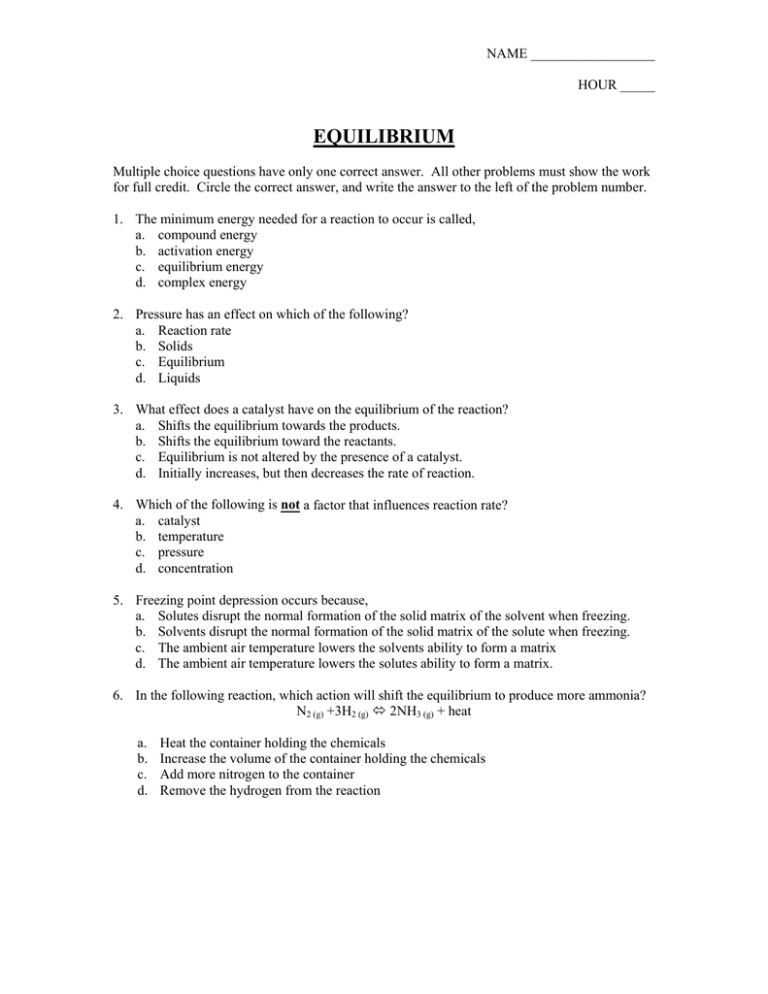EQUILIBRIUM
advertisement

NAME __________________ HOUR _____ EQUILIBRIUM Multiple choice questions have only one correct answer. All other problems must show the work for full credit. Circle the correct answer, and write the answer to the left of the problem number. 1. The minimum energy needed for a reaction to occur is called, a. compound energy b. activation energy c. equilibrium energy d. complex energy 2. Pressure has an effect on which of the following? a. Reaction rate b. Solids c. Equilibrium d. Liquids 3. What effect does a catalyst have on the equilibrium of the reaction? a. Shifts the equilibrium towards the products. b. Shifts the equilibrium toward the reactants. c. Equilibrium is not altered by the presence of a catalyst. d. Initially increases, but then decreases the rate of reaction. 4. Which of the following is not a factor that influences reaction rate? a. catalyst b. temperature c. pressure d. concentration 5. Freezing point depression occurs because, a. Solutes disrupt the normal formation of the solid matrix of the solvent when freezing. b. Solvents disrupt the normal formation of the solid matrix of the solute when freezing. c. The ambient air temperature lowers the solvents ability to form a matrix d. The ambient air temperature lowers the solutes ability to form a matrix. 6. In the following reaction, which action will shift the equilibrium to produce more ammonia? N2 (g) +3H2 (g) Ù 2NH3 (g) + heat a. b. c. d. Heat the container holding the chemicals Increase the volume of the container holding the chemicals Add more nitrogen to the container Remove the hydrogen from the reaction NAME __________________ HOUR _____ For 7-9 use the following answers, for 7-10 use the following chemical reaction. (You may need to balance the equation.) a. To the left b. To the right c. No shift occurs d. None of the above NaNO3 (g) + MgCl2 (s) Æ Mg(NO3)2 (s) + NaCl (s) + 102 KJ 7. In which direction does the reaction shift with the addition of Magnesium Nitrate? 8. In which direction does the reaction shift with a decrease in pressure? 9. In which direction does the reaction shift when a Rhodium catalyst is added to the mixture? 10. Which of the following is the correct Equlibrium expression for the above reaction? a. Keq = [NaNO3] [MgCl2] b. Keq = [NaNO3] [MgCl2] / [Mg(NO3)2] [NaCl] c. Keq = [Mg(NO3)2] [NaCl] / [NaNO3] [MgCl2] d. Keq = Kf / Kr e. None of the above 11. Calculate the Keq of the ammonia reaction in problem #6 if the concentrations are, N2= 0.25M, H2= 0.15M, and NH3= 0.10M. 12. Calculate the forward reaction rate constant for the reaction in problem #6 if the concentration are, N2=.100 M and H2=.250 M, if the forward rate = .0150 mole/dm3/s. 13. Bromine chloride decomposes to form chlorine, and bromine. 2BrCl(g) Ù Cl2 (g) + Br2 (g) The equilibrium constant for the reaction is 11.1, and the equilibrium mixture contains 4.00 mol of Cl2. How many moles of Br2 and BrCl are present in the equilibrium mixture. 14. The decomposition of hydrogen iodide produces an equilibrium mixture that contains 0.50 mol of hydrogen. The equilibrium constant for the reaction is 0.020. How many moles of iodine and hydrogen iodide are present in the equilibrium mixture? 2HI Ù H2 + I2





